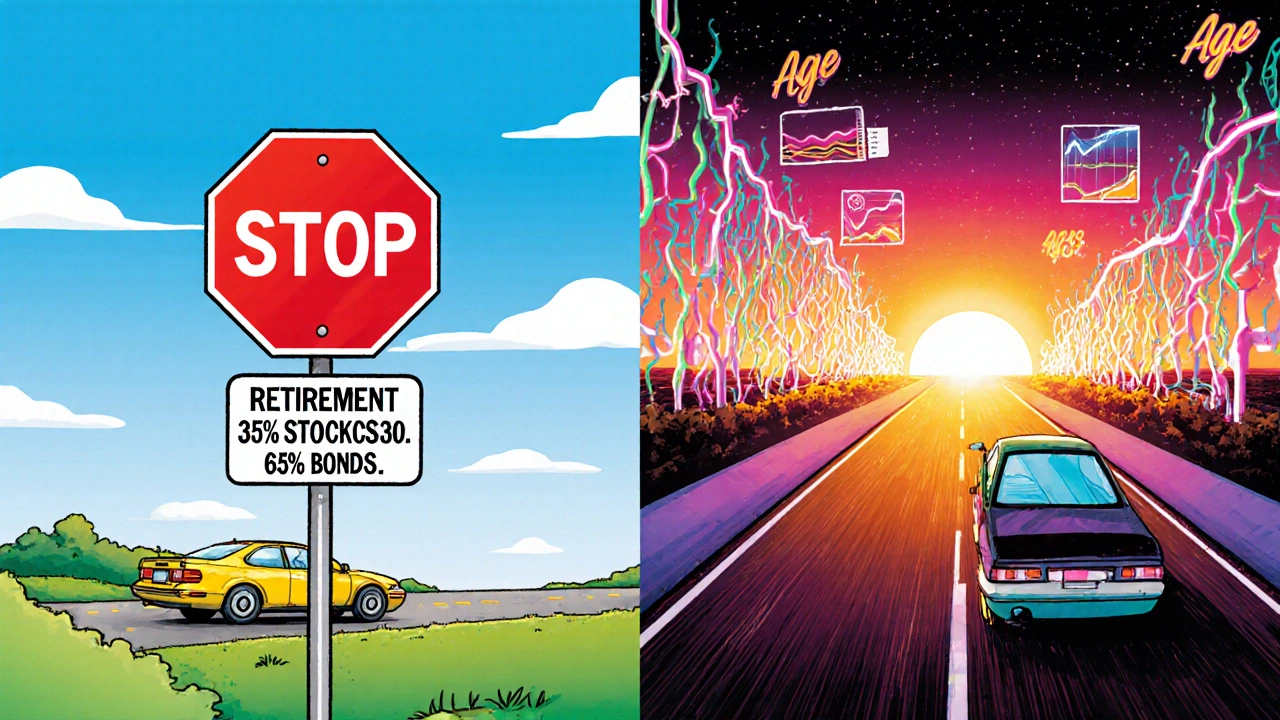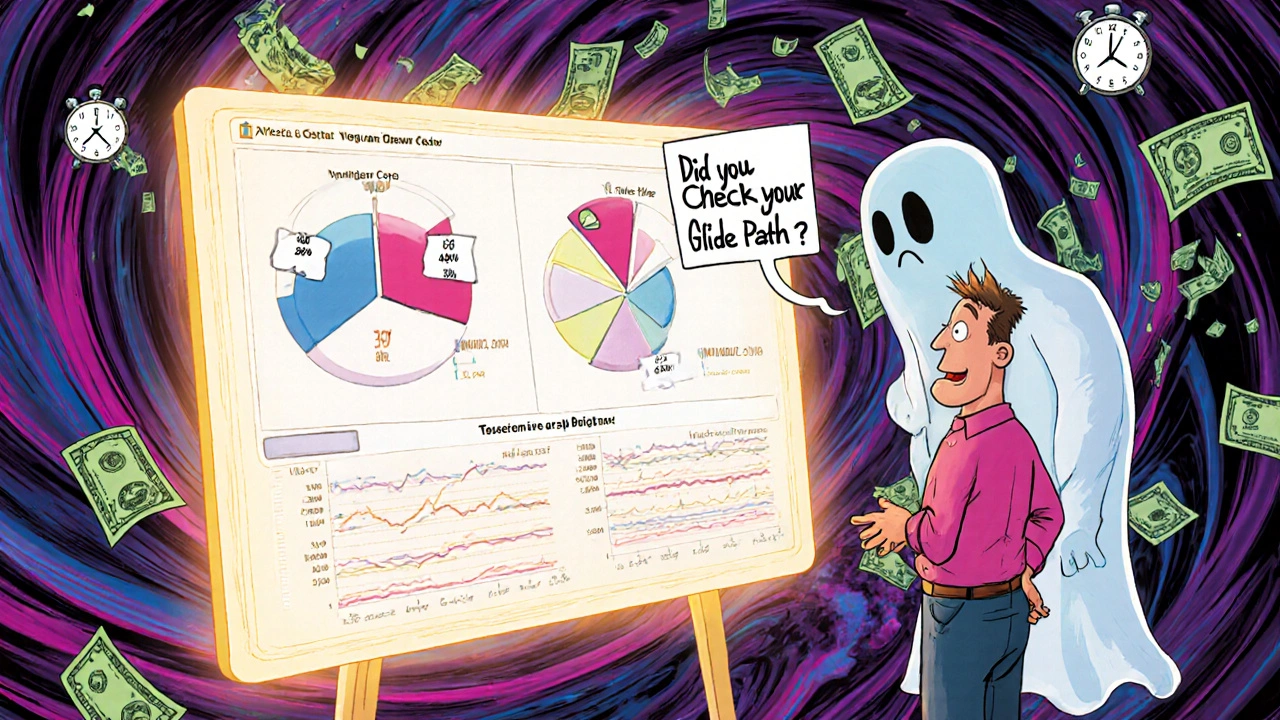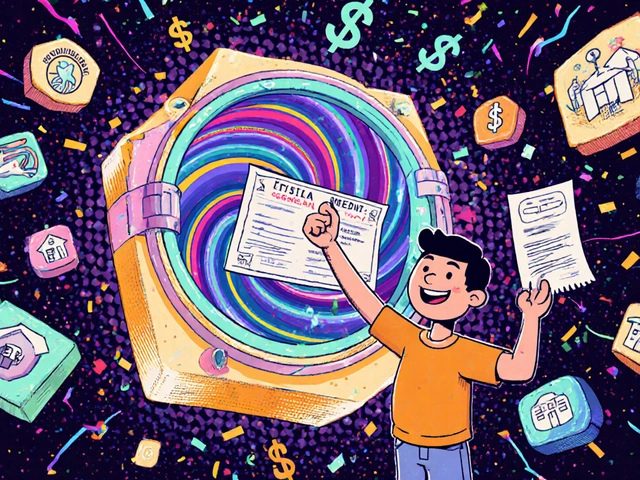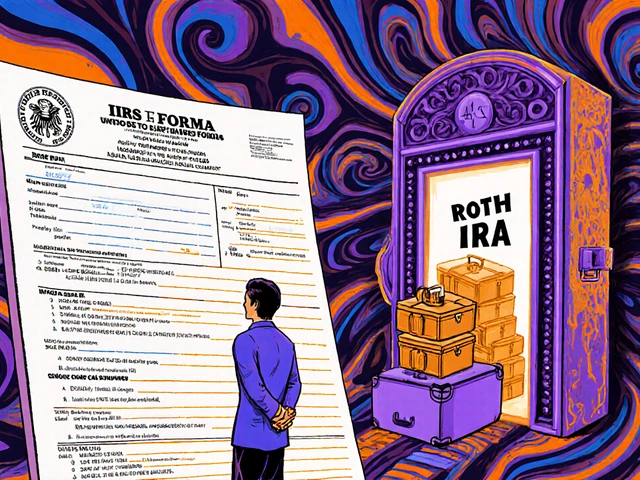When you pick a target-date fund for your 401(k), you’re not just choosing a fund-you’re trusting a plan that quietly reshapes your money over decades. The magic isn’t in the fund’s name or its manager. It’s in the glide path: the invisible roadmap that slowly shifts your portfolio from aggressive growth to steady preservation as retirement nears. Most people don’t think about it. But if you’re planning to retire in 15 or 20 years, understanding how this path works could mean the difference between running out of money and retiring with confidence.
What Exactly Is a Glide Path?
A glide path is the scheduled change in how a target-date fund invests your money. When you’re young-say, 30 years from retirement-the fund puts most of your money into stocks. That’s because you have time to ride out market crashes. But as you get closer to retirement, the fund automatically sells some stocks and buys bonds and cash. Why? Because you can’t afford to lose half your savings right before you need them. This isn’t random. Every major fund provider-Vanguard, Fidelity, T. Rowe Price, BlackRock-has its own glide path. But they all follow the same logic: reduce risk as you age. Think of it like a car slowing down as it approaches a stop sign. You don’t slam the brakes at 60 mph. You ease off the gas, then tap the brake. That’s what a glide path does for your retirement savings.How Much Risk Are You Really Carrying?
Here’s what the numbers look like in practice. For a fund targeting retirement in 2050, you might start with 90% in stocks and 10% in bonds. That’s aggressive. But by the time you’re 10 years from retirement, that mix might drop to 60% stocks and 40% bonds. At retirement, it could be 30% stocks, 60% bonds, and 10% cash. That’s a huge shift. But not all funds are built the same. Some, like Vanguard’s, use a straight-line glide path. That means they reduce stock exposure slowly and steadily, year after year. Others, like T. Rowe Price, hold onto more stocks even after retirement. These are called through glide paths. They assume you’ll need your money to last 20 or 30 years after retiring-and that means keeping some growth in the portfolio. Then there are to glide paths. These funds stop changing once you hit your target date. Your portfolio locks in at, say, 35% stocks and stays there. That sounds safe. But if you live to 90, you might be too conservative too soon. Your money could lose value to inflation because it’s sitting mostly in bonds.Why Do Providers Design Glide Paths Differently?
Each company makes different assumptions about how long you’ll live, how much risk you can handle, and what kind of retirement you want. Vanguard, for example, assumes most people want stability after retirement. Their glide path ends with 30% stocks. Fidelity, on the other hand, assumes retirees might need more growth. Their 2055 fund still holds 27% stocks 15 years after retirement. T. Rowe Price is even more aggressive. Their 2050 fund keeps 44% in stocks two decades after retirement. That’s not for everyone. But for someone who plans to travel, support family, or just wants to outpace inflation, it makes sense. The difference isn’t just academic. A 2023 Fidelity study found that investors in through glide paths had 12% higher account balances at age 70 than those in to funds. But they also saw 23% more volatility during market drops. That’s the trade-off: higher potential returns, but more anxiety during downturns.
What Do Experts Say About Current Glide Paths?
Here’s the problem: most glide paths are too safe. Morningstar’s 2022 report found that the average target-date fund had only 46% in stocks at retirement. But financial advisors often recommend retirees keep 50% to 60% in stocks to keep up with inflation and extend their savings. That means most people are pulling back too early. Why? Because fund companies are playing it safe. They don’t want to be blamed if someone loses money right before retirement. So they dial down risk faster than necessary. But that creates a new risk: running out of money later in life. The Investment Company Institute found that 78% of retirement plan sponsors say glide path design is the most important factor when choosing a fund. But 62% admit they don’t know how to evaluate if a glide path is right for their employees. That’s a huge gap. Employers are picking funds based on marketing, not data.How to Choose the Right Glide Path for You
You don’t need to be a financial expert to pick the right fund. But you do need to ask yourself a few questions:- How long do you expect to live after retirement? If you’re healthy and your family lives into their 90s, you might need more growth.
- How do you feel when the market drops? If you panic and sell, a more conservative fund might help you sleep better.
- Will you need to withdraw money right away? If you’re retiring at 62 and need income, you might want a fund that keeps more bonds.
- Do you have other savings outside your 401(k)? If you do, you can afford to take more risk in your target-date fund.

What Happens If You Ignore the Glide Path?
Many people think their target-date fund will take care of everything. And it will-until it doesn’t. A 2022 Vanguard study found that only 28% of investors understand how their fund’s glide path works. That’s dangerous. One investor on Reddit said their fund dropped 25% in 2022. Their friend’s fund only dropped 15%. Why? Because their friend’s fund hadn’t cut stocks yet. The investor assumed their fund was safe. It wasn’t. It was still 70% in stocks because the target date was 2045, and they were only 50 years old. The fund hadn’t shifted yet. That’s not a flaw-it’s how glide paths work. But if you don’t know that, you’ll panic and sell. Another common mistake: picking a fund based on the year alone. If you’re 55 and plan to retire at 67, you shouldn’t pick a 2050 fund. That’s meant for someone retiring in 2050-someone who’s still 30. You need a 2035 fund. The year matters. Don’t just pick the closest one.The Future of Glide Paths
The industry is changing. BlackRock now builds glide paths with ESG factors. Fidelity is testing dynamic glide paths that adjust based on market conditions. The Department of Labor wants plan sponsors to prove their glide path choice matches their employees’ real-life profiles-not just averages. By 2025, J.P. Morgan predicts 60% of target-date funds will use personalized glide paths. That means your fund might adjust based on your salary, health, or even your spending habits. That sounds great. But it also sounds complicated. And that’s the risk. The whole point of target-date funds is simplicity. If they become too complex, people will stop using them. The best glide path isn’t the most advanced one. It’s the one you’ll stick with. As one Bogleheads user put it: "The best glide path is the one you’ll stick with through market volatility." If you’re constantly second-guessing your fund, you’re better off with a simple, clear glide path-and maybe a little extra cash in a separate account.Final Thought: Trust the Process, But Know the Plan
Target-date funds are one of the best tools for retirement savings. They remove emotion, automate rebalancing, and adjust for you. But they’re not magic. They’re math. And if you don’t understand the math, you’re just hoping for the best. Check your fund’s glide path. Know how much it holds in stocks at retirement. Know if it’s a "to" or "through" path. Compare it to your own goals. If it feels too conservative, find one that matches your risk tolerance. If it feels too risky, dial it back. You don’t need to manage your portfolio daily. But you do need to understand the plan you’ve chosen. Your retirement isn’t a guess. It’s a journey. And your glide path is the map. Make sure you’ve read it.What does a glide path do in a target-date fund?
A glide path is the automatic schedule that shifts a target-date fund’s investments from mostly stocks to mostly bonds and cash as the target retirement date approaches. It reduces risk over time so your savings aren’t exposed to big market drops right before you need the money.
What’s the difference between a "to" and "through" glide path?
A "to" glide path stops changing once you reach the target retirement date, locking in a conservative mix like 30% stocks and 70% bonds. A "through" glide path keeps adjusting after retirement, often keeping 40% to 50% in stocks for 10-20 years beyond the target date to help your money last longer in retirement.
Are target-date funds too conservative?
Many are. The average target-date fund has only 46% in stocks at retirement, but financial experts often recommend 50% to 60% to fight inflation and stretch savings. If you expect to live 20+ years in retirement, a more aggressive glide path might be better.
How do I find my fund’s glide path?
Go to your fund provider’s website-Vanguard, Fidelity, T. Rowe Price-and search for "glide path" or "asset allocation" for your specific fund. They all publish detailed charts showing how stock and bond exposure changes over time.
Should I pick a target-date fund based on my age or my retirement year?
Pick it based on your retirement year, not your age. If you plan to retire at 65 in 2040, choose a 2040 fund-even if you’re 45 now. Don’t pick a 2050 fund just because you’re young. That fund is designed for someone retiring in 2050, not you.
Can I change my glide path after I’ve chosen a fund?
Yes. You can switch to a different target-date fund at any time through your 401(k) plan. If your current fund’s glide path is too conservative or too aggressive for your goals, pick one that better matches your risk tolerance and expected retirement length.
Do glide paths work in a bear market?
They’re designed to help. A well-structured glide path reduces exposure to stocks before a major downturn near retirement. But if you’re still 10-15 years out, your fund may still be 70%+ in stocks-which means you’ll feel the drop. That’s normal. The point is to avoid being fully exposed right before you retire.






Comments
This is actually super helpful. I never realized how much the glide path matters. My fund's at 30% stocks at retirement and I'm 38-guess I'm gonna switch to a through-path. 🤔
I appreciate how you broke this down without jargon. I used to think target-date funds were set-and-forget, but now I see I need to actually read the fine print. My 2045 fund still has 68% stocks-I'm 47, so that makes sense, but I didn't know that was normal. Thanks for the clarity.
OMG I just checked my Fidelity 2050 fund and it's still holding 41% stocks at 70?? I thought I was being safe, but now I'm like... wait, is this actually the secret sauce?? I'm switching my wife's fund too. She's 52 and we're planning to live until 95. This is game-changing. 🙌
The fact that 78% of plan sponsors say glide paths are the most important factor but 62% admit they don't know how to evaluate them is a national disgrace. This isn't finance-it's gambling with people's life savings. Fund providers are hiding behind 'conservatism' to avoid liability, not to serve retirees. If your glide path doesn't account for 30-year retirements, it's obsolete. And yes, I'm calling out Vanguard's 30% stock cap. It's a relic. We need dynamic, personalized glide paths NOW.
It is fascinating to consider how the glide path, while ostensibly a mechanical and mathematical construct, in reality reflects deeply human assumptions about mortality, risk tolerance, and societal expectations of aging. We are told to 'plan for retirement' as if it were a single endpoint, yet life expectancy has stretched far beyond the models that underpin most glide paths. The industry's reluctance to embrace higher equity allocations post-retirement stems not from evidence, but from fear-fear of blame, fear of volatility, fear of being the one who 'let someone lose everything.' But what if the greater risk is not losing money in a downturn, but losing the ability to live fully in one's later years because one's portfolio was too timid? I find myself wondering: if we are living longer, healthier lives, why are we investing as if we will die at 70? Perhaps the true glide path should not be time-based at all, but life-expectancy-based, or even health-status-based. The future of retirement planning, I believe, lies not in simplification, but in nuanced, individualized design-though I fear most will still choose the easiest option, simply because understanding is hard. And so we remain, in our 401(k)s, quietly trusting maps we never learned to read.